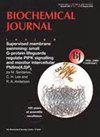铜绿假单胞菌VI型分泌系统毒素Tse8是由一种新型n -氨甲酰腐胺水解酶进化而来的。
IF 4.3
3区 生物学
Q2 BIOCHEMISTRY & MOLECULAR BIOLOGY
引用次数: 0
摘要
多胺腐胺主要是由细菌中的l -精氨酸通过agmatine合成的。目前已知有三种途径从胍丁氨酸转化为腐胺,包括通过胍丁氨酸酶直接转化。另外两种途径是利用agmatine脱亚胺酶将agmatine转化为n -氨基甲酰基腐胺,然后利用两种非同源酶中的一种,即腐胺转氨基甲酰基腐胺酶或n -氨基甲酰基腐胺氨基水解酶(NCPAH)将n -氨基甲酰基腐胺转化为腐胺。在这里,我们从系统发育上遥远的细菌,γ -变形细菌谢氏杆菌和放线菌种Microterricola gilva中功能性鉴定酶,这些酶是新的替代,非同源,非规范的NCPAHs,我们称之为AguY,它们是通过趋同进化出现的。动力学分析表明,AguY酶与铜绿假单胞菌的典型NCPAH酶一样有效地将n -氨基甲酰腐胺转化为腐胺。基因组证据表明,AguY酶可能参与腐胺生物合成或agmatinine分解代谢途径,并且偶尔在编码agmatinase的基因组中编码。我们发现铜绿假单胞菌的VI型分泌系统毒素Tse8是从AguY进化而来的。从形式上看,AguY可能直接或间接地从古老的谷氨酰胺酰胺水解酶GatA进化而来,GatA是转胺体的一个组成部分,转胺体是一种RNA/蛋白质复合物,用于生产谷氨酰胺携带的tRNA。我们的研究为多胺生物合成中趋同进化和水平基因转移的普遍存在提供了进一步的例子,表明细菌进化多胺代谢的普遍选择压力。本文章由计算机程序翻译,如有差异,请以英文原文为准。
The Pseudomonas aeruginosa Type VI secretion system toxin Tse8 evolved from a novel N-carbamoylputrescine amidohydrolase.
The polyamine putrescine is synthesized primarily from L-arginine via agmatine in bacteria. There are currently three known routes from agmatine to putrescine, including direct conversion by agmatinase. The other two routes use agmatine deiminase to produce N-carbamoylputrescine from agmatine, then one of two nonhomologous enzymes, putrescine transcarbamylase or N-carbamoylputrescine amidohydrolase (NCPAH) convert N-carbamoylputrescine to putrescine. Here, we functionally identify enzymes from phylogenetically distant bacteria, the gamma-proteobacterium Shewanella oneidensis, and the actinomycetota species Microterricola gilva, that are novel alternative, nonhomologous, noncanonical NCPAHs that we term AguY, which have emerged by convergent evolution. Kinetic analysis indicates that the AguY enzymes are as efficient as the canonical NCPAH from Pseudomonas aeruginosa, in converting N-carbamoylputrescine to putrescine. Genomic evidence suggests that the AguY enzymes may participate in putrescine biosynthetic or agmatine catabolic pathways, and are occasionally encoded in genomes that also encode agmatinase. We show that the Type VI secretion system toxin Tse8 from Pseudomonas aeruginosa has evolved from AguY. It is formally possible that AguY evolved directly or indirectly from the ancient glutamine amidohydrolase GatA, a component of the transamidosome, an RNA/protein complex required for production of glutamine-charged tRNA. Our study provides a further example of the prevalence of convergent evolution and horizontal gene transfer in polyamine biosynthesis, suggesting pervasive selective pressure to evolve polyamine metabolism in bacteria.
求助全文
通过发布文献求助,成功后即可免费获取论文全文。
去求助
来源期刊

Biochemical Journal
生物-生化与分子生物学
CiteScore
8.00
自引率
0.00%
发文量
255
审稿时长
1 months
期刊介绍:
Exploring the molecular mechanisms that underpin key biological processes, the Biochemical Journal is a leading bioscience journal publishing high-impact scientific research papers and reviews on the latest advances and new mechanistic concepts in the fields of biochemistry, cellular biosciences and molecular biology.
The Journal and its Editorial Board are committed to publishing work that provides a significant advance to current understanding or mechanistic insights; studies that go beyond observational work using in vitro and/or in vivo approaches are welcomed.
Painless publishing:
All papers undergo a rigorous peer review process; however, the Editorial Board is committed to ensuring that, if revisions are recommended, extra experiments not necessary to the paper will not be asked for.
Areas covered in the journal include:
Cell biology
Chemical biology
Energy processes
Gene expression and regulation
Mechanisms of disease
Metabolism
Molecular structure and function
Plant biology
Signalling
 求助内容:
求助内容: 应助结果提醒方式:
应助结果提醒方式:


